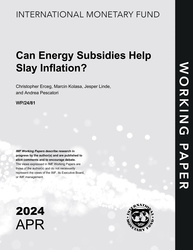
Can Energy Subsidies Help Slay Inflation?
Can Energy Subsidies Help Slay Inflation?
READ MORE...
Volume/Issue:
Volume 2024
Issue 081
Publication date: April 2024
ISBN: 9798400273445
$20.00
Add to Cart by clicking price of the language and format you'd like to purchase
Available Languages and Formats
| English |
Prices in red indicate formats that are not yet available but are forthcoming.
Topics covered in this book
This title contains information about the following subjects.
Click on a subject if you would like to see other titles with the same subjects.
Inflation , Economics- Macroeconomics , Public Finance , Economics / General , Energy Prices , Energy Subsidies , Monetary Policy , International Spillovers , closed economy model , headline inflation , Phillips curve , core CPI , equilibrium allocation , price inflation , Energy pricing , Inflation , Government subsidies , Global , Europe
Summary
Many countries have used energy subsidies to cushion the effects of high energy prices on households and firms. After documenting the transmission of oil supply shocks empirically in the United States and the Euro Area, we use a New Keynesian modeling framework to study the conditions under which these policies can curb inflation. We first consider a closed economy model to show that a consumer subsidy may be counterproductive, especially as an inflation-fighting tool, when applied globally or in a segmented market, at least under empirically plausible conditions about wage-setting. We find more scope for energy subsidies to reduce core inflation and stimulate demand if introduced by a small group of countries which collectively do not have much influence on global energy prices. However, the conditions under which consumer energy subsidies reduce inflation are still quite restrictive, and this type of policy may well be counterproductive if the resulting increase in external debt is high enough to trigger sizeable exchange rate depreciation. Such effects are more likely in emerging markets with shallow foreign exchange markets. If the primary goal of using fiscal measures in response to spikes in energy prices is to shield vulnerable households, then targeted transfers are much more efficient as they achieve their goals at lower fiscal cost and transmit less to core inflation.
Copyright © 2010 - 2025
Powered by:
AIDC



